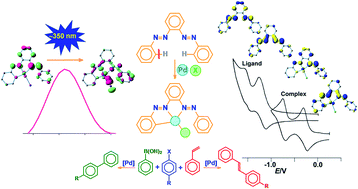Insight into luminescent bisazoaromatic CNN pincer palladacycle: synthesis, structure, electrochemistry and some catalytic applications in C–C coupling†
Abstract
Chelating behavior of a potential flexidentate bisazoaromatic molecule 2-(phenylazo)azobenzene (PAAB) toward palladium have been examined. Activation of one instead of the two C(Ph)–H bonds of PAAB (HL) in the course of the metallation furnishes an exclusive unsymmetrical mode of ligation. Consequently, another member of the important class of CNN pincer palladacycles is achieved in almost quantitative yields. Crystallographic analysis authenticates the monoanionic terdentate ligation of the bisazoaromatic molecule and neutral [PdII(L)X] (X = acetate and halides) complexes with planar palladacycle and out-of-plane pendant phenyl ring. Unlike the N-donor pincers incorporating imine moieties, the introduction of two azo chromophores not only makes the PAAB ligand strongly π-acidic but also significantly modulates the FMOs in the palladacycles. An appreciable lowering of ligand-centered (LC) π* orbitals is apparent upon complexation which is in accordance with the electrochemical responses where large anodic shifts of LC LUMO and LUMO + 1 by 0.8–0.9 V have been noted. The significant modification of FMOs leads to interesting optoelectronic properties in the palladacycles. The cyclopalladated compounds are luminescent in solution at room temperature. This property is plausibly a result of the LC emissive states (azo π*). The optoelectronic features are interpreted by the Time-Dependant (TD) density functional theory (DFT) and natural transition orbital (NTO) analyses. In addition, scrutiny of Suzuki–Miyaura and Heck-type reactions indicates that the pincer palladacycles may be employed in the development of useful catalysts for C–C coupling reactions.

- This article is part of the themed collection: Nanoscience and nanotechnology in electrochemistry

 Please wait while we load your content...
Please wait while we load your content...